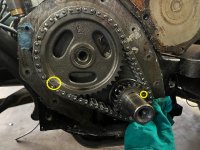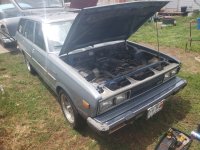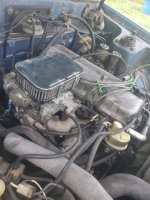You are using an out of date browser. It may not display this or other websites correctly.
You should upgrade or use an alternative browser.
You should upgrade or use an alternative browser.
Weber 38/38 DGS and various Distributors
- Thread starter Sickboy49
- Start date
Sickboy49
Well-known member
Got the new head gasket installed and it seems to be holding. I had the engine running for about 20 minutes. I still have the same issue with it not staying running at idle however.... I found that I am a tooth or two off on the distributor. I was able to figure that out with a vacuum gauge hooked up to the intake manifold. I plan on pulling the distributor tomorrow and setting it correctly. Fingers crossed.
Good deal! . . If there is enough room to rotate the distributor body, you can in leu of removing it. If you want the vacuum can facing just-so then removal and re-keying will be necessary. How did you determine it's off? Late timing?Got the new head gasket installed and it seems to be holding. I had the engine running for about 20 minutes. I still have the same issue with it not staying running at idle however.... I found that I am a tooth or two off on the distributor. I was able to figure that out with a vacuum gauge hooked up to the intake manifold. I plan on pulling the distributor tomorrow and setting it correctly. Fingers crossed.
Sickboy49
Well-known member
Well I am about ready to lose my mind. After adjusting the distributer multiple times the engine is still not idling. It still wants to be at +30 degrees just to keep it running between 700-800 rpm. Above 1000 rpm she runs like a champ. It makes me sick that I turned my car into a 2 ton paperweight.
You've generally been following a good diagnostic path but it just hasn't led you to the problem. I'm going to jump outside the box and relay a couple of thoughts that have been running around in the back of my mind.
Was the engine running properly on the original carburetor and intake manifold? Or did you install the carb & manifold as part of the rebuild?
Have you thoroughly checked for vacuum leaks at the intake manifold to cylinder head connection? That's a big problem area, especially with aftermarket aluminum manifolds. I have heard of problems, specifically, with current versions of the Clifford manifold where owners have had to have them resurfaced.
With the distributor set at 30 degrees advance, is your vacuum gauge still reading low and showing late timing? If so, is there any possibility that your timing chain might be a tooth off?
Keep us posted with what you find.
Lou Manglass
Was the engine running properly on the original carburetor and intake manifold? Or did you install the carb & manifold as part of the rebuild?
Have you thoroughly checked for vacuum leaks at the intake manifold to cylinder head connection? That's a big problem area, especially with aftermarket aluminum manifolds. I have heard of problems, specifically, with current versions of the Clifford manifold where owners have had to have them resurfaced.
With the distributor set at 30 degrees advance, is your vacuum gauge still reading low and showing late timing? If so, is there any possibility that your timing chain might be a tooth off?
Keep us posted with what you find.
Lou Manglass
Adding to the above- the damper timing mark may be off. . Late timing or lean mixture will often produce an intake backfire. when it's stumbling at idle, or during working the throttle, does it cough-back in the intake? If so then lean and/or late valve and/or ignition timing is cause.
If all of this was caused by the carb change, go back to the other one!
If all of this was caused by the carb change, go back to the other one!
Sickboy49
Well-known member
Lou,You've generally been following a good diagnostic path but it just hasn't led you to the problem. I'm going to jump outside the box and relay a couple of thoughts that have been running around in the back of my mind.
Was the engine running properly on the original carburetor and intake manifold? Or did you install the carb & manifold as part of the rebuild?
Have you thoroughly checked for vacuum leaks at the intake manifold to cylinder head connection? That's a big problem area, especially with aftermarket aluminum manifolds. I have heard of problems, specifically, with current versions of the Clifford manifold where owners have had to have them resurfaced.
With the distributor set at 30 degrees advance, is your vacuum gauge still reading low and showing late timing? If so, is there any possibility that your timing chain might be a tooth off?
Keep us posted with what you find.
Lou Manglass
After the rebuild I used an Autolite 1100 and the original intake/exhaust manifold, just to get her up and running. It ran but not great, but at least it would idle.
I have gone over the Clifford intake manifold multiple times looking for vacuum leaks and have found no leaks. After I put the latest head gasket on I used the copper permatex on the intake/exhaust gasket to ensure a good seal, just in case. When it is running I then went over the whole area with an unlit propane torch to see if I could detect any leaks. I found nothing.
Your assumption is correct. With 30 degrees timing the vacuum is still reading low/late timing. I am beginning to think that the timing chain is off as well, or the harmonic balancer with the timing marks on it is off. I would not think that is out of the realm of possibility since this is the third head gasket I had to install after I got it back from the engine builder. I am going to take the valve cover off and check to make sure the valves are closed when the rotor is at the number one position and see if the #1 piston is truly at top dead center.
Sickboy49
Well-known member
Frank,Adding to the above- the damper timing mark may be off. . Late timing or lean mixture will often produce an intake backfire. when it's stumbling at idle, or during working the throttle, does it cough-back in the intake? If so then lean and/or late valve and/or ignition timing is cause.
If all of this was caused by the carb change, go back to the other one!
Funny I just thought of the damper being off as well. I am in to deep to go back now to the original, since it did not run very well after the rebuild..... but I will have to keep that in mind.
10-4. It doesn't really matter if it's off, technically. If in doubt use a piston-stop to verify true TDC and mark the damper accordingly. Also verifying TDC will give you an accurate benchmark for judging the valve timing. Hang in there! These projects seem to stretch out into eternity, like they were in a different time-realm. Feel like I'm never going to complete my current project. An engine "refresh" has turned into a full-blow costly overhaul with a never-ending list of small tweaks and changes! LOLFrank,
Funny I just thought of the damper being off as well. I am in to deep to go back now to the original, since it did not run very well after the rebuild..... but I will have to keep that in mind.
Sickboy49
Well-known member
Thank you for the encouragement, I really need that right now. I have been second guessing myself constantly with the Mallory distributor and the Weber. Going from one to the other in a never ending cycle of not accomplishing anything, and ending up thinking I should never touch an engine/car again, when it all may come down to someone else's mistake.10-4. It doesn't really matter if it's off, technically. If in doubt use a piston-stop to verify true TDC and mark the damper accordingly. Also verifying TDC will give you an accurate benchmark for judging the valve timing. Hang in there! These projects seem to stretch out into eternity, like they were in a different time-realm. Feel like I'm never going to complete my current project. An engine "refresh" has turned into a full-blow costly overhaul with a never-ending list of small tweaks and changes! LOL
Sickboy49
Well-known member
Last night I performed a simple test of seeing where #1 TDC was on the actually cylinder regardless of the timing marks on the pulley. I found that TDC was about 4 degrees before the TDC mark on the pulley. After adjusting the distributor I tried firing it up with no luck. I also think the valves are still open a little bit, and that is why my compression numbers suck. 90 PSI across all cylinders when it should be 150 PSI +- 10. It looks as though I will have to pull the timing cover and see how many teeth I am off. The fun continues... LOL
Sickboy49
Well-known member
I removed the radiator and water pump this weekend so I could get at the timing chain cover a little easier and to give myself clearance for the gear puller. I verified that #1 I was top dead center, and that the distributor was pointing to #1. So Frank and Lou were correct.... I am not just off teeth I am off about 180 degrees as you can see by the dots on the came gear and crank sprocket, and how the key ways line up as well.. I have no idea how the motor even ran. This explains the compression and idle issue. I am going to order new gaskets and seals today. Hopefully I can get her back up and running this upcoming weekend.


As I recall, that happens when the timing marks are lined up in traditional fashion. Bring the crankshaft around one turn to TDC again and see if the timing marks line up with the 12 links as in the service manual. If they do, just reset the distributor to #1. Number one should be piston at TDC, valves closed, and rotor pointing at #1.
Lou Manglass
Lou Manglass
Sickboy49
Well-known member
Thank you Lou. I did not even think of resetting it like that.As I recall, that happens when the timing marks are lined up in traditional fashion. Bring the crankshaft around one turn to TDC again and see if the timing marks line up with the 12 links as in the service manual. If they do, just reset the distributor to #1. Number one should be piston at TDC, valves closed, and rotor pointing at #1.
Lou Manglass
Sickboy49
Well-known member
Continued fun times with the timing. I rotated the crank one full turn with #1 TDC and the marks lined up (12 pins in between the dots) and the valves were closed... however.... I am now on the wrong stroke. I verified this by turning the motor and seeing which valve on #1 opened. The intake opened instead of the exhaust. If I was TDC on the compression stroke the next valve to open would be the exhaust. I am kicking myself for not verify this before I put the timing cover and pulley back on. Live and learn, and at least gaskets are cheap.
When the engine is on TDC after the exhaust stroke, both valves are actually still open a few thousands. When at TDC compression, they're fully closed. This may help figure which TDC you're on.Continued fun times with the timing. I rotated the crank one full turn with #1 TDC and the marks lined up (12 pins in between the dots) and the valves were closed... however.... I am now on the wrong stroke. I verified this by turning the motor and seeing which valve on #1 opened. The intake opened instead of the exhaust. If I was TDC on the compression stroke the next valve to open would be the exhaust. I am kicking myself for not verify this before I put the timing cover and pulley back on. Live and learn, and at least gaskets are cheap.
So you're saying with the timing marks aligned, as you rotated the engine the intake valve opened? Verify you're rotating the correct direction. If rotation is correct it's at TDC on the overlap stroke, in which case the marks should not be aligned.
Sickboy49
Well-known member
Correct, the intake valve opened. Also for the matter of rotating the motor in the correct direction.... I am orientated at the front bumper looking at the windshield, I turn the motor clockwise.When the engine is on TDC after the exhaust stroke, both valves are actually still open a few thousands. When at TDC compression, they're fully closed. This may help figure which TDC you're on.
So you're saying with the timing marks aligned, as you rotated the engine the intake valve opened? Verify you're rotating the correct direction. If rotation is correct it's at TDC on the overlap stroke, in which case the marks should not be aligned.
Sickboy49
Well-known member
Found something very interesting yesterday that still has me scratching my head. The above photo is actually how the cam and crank have to be aligned in order for it to be on TDC compression stroke. I verified this by taking the cam gear and and chain off, and rotating the cam until the keyway was pointing down. This "should" be the correct position, but the intake valve opened instead of the exhaust. So it would seem the keyway was machined 180 degrees of from what it should be.
After figuring that out... has anyone ever heard of a scenario like this? If I put the cam gear and chain back on in this position, my timing is about 180 degrees off, and I will have to pull the distributor and reset it.
Also an FYI... I verified the valves were completely closed by buying a scope from harbor freight.
After figuring that out... has anyone ever heard of a scenario like this? If I put the cam gear and chain back on in this position, my timing is about 180 degrees off, and I will have to pull the distributor and reset it.
Also an FYI... I verified the valves were completely closed by buying a scope from harbor freight.
Sickboy49
Well-known member
I set the timing per the shop manual, and found that I was 180 degrees off. I reset the distributor and wouldn't you know it, she fired up. It took me awhile of adjusting the distributor, idle speed, and mixtures but I got her to idle without the choke being on. It is still high at 850 RPM but it is a start. I have a vacuum gauge hooked to the intake manifold and it is telling me I have a vacuum leak somewhere. The needle keeps moving back and forth and should be steady. So I am going to check for vacuum leaks again and see where that leads me.
Similar threads
- Replies
- 14
- Views
- 653
All Small Six
Weber 38/38 DGES jets, emulsion tubes and settings
- Replies
- 19
- Views
- 4K
- Replies
- 26
- Views
- 3K
- Replies
- 5
- Views
- 811
- Replies
- 1
- Views
- 761


